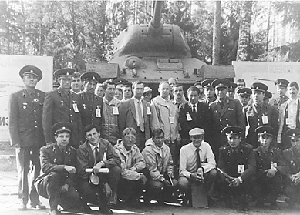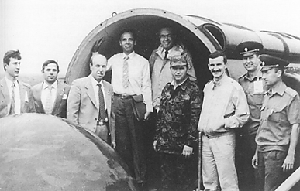 During the baseline inspection period (July - August 1988), Colonel Kelley and his team conducted many inspections. Here the American inspectors together with their Soviet escorts assembled in front of a T-34 tank at Vyru, an SS-4 missile operating base in Estonia. |
The
process began at the airport, where Colonel Kelley and
the team were met by Colonel Ivan Y. Abrosimov, the
Soviet escort leader, and his team members. Representing
the agency in Moscow were Lt. Colonel Ken Keating, U.S.
Army, Eileen Malloy, U.S. State Department, and Sergeant
First Class John Steinmetz, U S. Army. They met the
American inspection team at the airport, and along with
the Soviet escort team, they accompanied the aircrew to
customs, and then to their overnight accommodations in
Moscow. After a treaty-specified four-hour minimum
period, Kelley declared the American inspection team's
intention to inspect the Soviet SS-20 missile operating
base at Rechitsa in Byelorussia. From the time of that
declaration, the Soviet Union had nine hours to get the
U.S. inspection team to the site. The Soviets met the treaty deadline. The U.S. inspectors and their Soviet escorts flew from Moscow to Byelorussia and then were taken by bus to the SS-20 missile base. When Kelley's team arrived at the site, they proceeded immediately to a pre-inspection briefing by the Soviet missile site commander. Required by the treaty, this briefing ran approximately an hour and included a presentation of a site diagram describing the location of the missiles, stages, launchers, support equipment, and support structures. The diagram also included data on the exact number of treaty items. At this time, the American inspectors were provided with information on safety and potential hazards at the site. Following this briefing, Kelley and his team commenced their baseline inspection at 0001 hours GMT (0401 local), July 2. They made a thorough inspection of the entire site, escorted throughout by Soviet INF officials knowledgeable about the treaty. The inspecting party had the treaty right of conducting a 24-hour inspection; however, approximately eight hours after the inspection began, Kelley declared it completed. Assisted by the linguists and other inspectors, Colonel Kelley prepared the treaty inspection report in English and Russian.12 |
